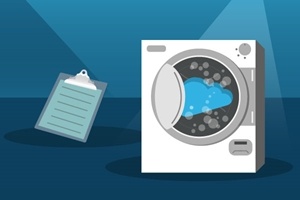Have you ever used the phrase "laundry list," as in "I have a long laundry list of things to do today," or "Our nonprofit finance team has a whole laundry list of stakeholders and charts of accounts to go through?" It is an odd set of words, since most people these days probably are not making handwritten lists of clothes to be washed, or jotting them down one by one - "1x sweater," "2x pants," etc. - into a mobile reminders app so that they can later be checked off.
What laundry lists and Excel sheets have in common
The term is actually a leftover from the heyday of commercial laundries and dry cleaners. Back then, customers would drop off their laundry and then the business staff would mark and sort it, to ensure that it went through the proper wash cycle and was then returned to the right people. Everything was recorded along the way on an actual printed laundry list, which served as a sort of mini ledger for each batch of clothing.
The literal laundry list may have mostly passed into the history books, but the turn of phrase lives on. For nonprofit organizations, however, their accounting practices can still feel a lot like something that came straight out of that original laundry list era: heavy on manual processes, prone to errors or miscalculations and full of hard-to-parse data. They may not be doing laundry, but it can nevertheless be tough for them to keep the books on all of their funds clean, neat and in order.
Laundry list makers had their scrawled marks for "chemises" (smocks) and "counterpanes" (bedspreads, more or less), while today's accountants have their implementation resource schedules in Excel as well as their separate siloed applications for customer relationship management and financial oversight. Neither system is ideal in this day and age. But unlike laundry lists, spreadsheets and similar legacy solutions are still alive and well in modern business.
The complexity of nonprofit accounting in 2016 and beyond
Laundries were known for their complicated record keeping systems, which went so far as to draw a fine line between "soft-collar shirts" and "sports shirts." There was a reason for this granularity, though: These organizations handled many different types of clothes with a wide range of respective temperature requirements.
"Nonprofits often process data using tools not fit for the job."
Nonprofits also have to process data from a multitude of sources, often while using tools that are simply not fit for the job. Consider the common situation of a firm that has to comb through its various funds, grants, projects, programs and more, using Excel or traditional on-prem accounting software. This basic mismatch of the vast scope of the challenge and the limited means of the solution creates recurring challenges in areas such as:
Grant tracking
Providers of grants often introduce a lot of complexity into nonprofit accounting by not specifying a year-end for their funds and/or limiting those monies to certain expenses. Nonprofits must keep tabs on how much deferred revenue is in each grant account, which grants are receivable and what expenses are being paid by these grants. Accurate tracking is essential not only for managing current finances, but also for increasing the chance of winning additional grants in the future.
Dealing with cash flow
Nonprofits are reliant on different funding sources - e.g. grants and pledges - than other types of organizations, which can lead to unique difficulties in managing their incoming and ongoing dollars. For context, two of the biggest nonprofit accounting problems cited by a late 2015 survey were related to reporting and employee training - both of which are crucial to proper cash flow management.
The abilities to parse financial reports, gain visibility into possible cash-related issues and ultimately make informed decisions about the firm's finances are all pillars of effective nonprofit accounting. However, there are numerous bottlenecks to address on the way to success, on both the technical and cultural sides. These obstacles include delays in generating and distributing accurate, one-version-of-the-truth reports with business budgeting software, as well as problems for employees who may not be used to the nonprofit sector yet.
Serving all stakeholders
As the original laundry list proves, organizations often end up resorting to time-consuming and labor-intensive ways to ensure that all of their customers are adequately served. Nonprofits are no different. In supplying reports and responses to their numerous stakeholders, they depend deeply on old-fashioned tools.

Nonprofits have to strain to provide information to many different stakeholders.
A typical nonprofit has, well, an extensive laundry list of stakeholders to constantly keep in the loop about its finances. These groups may include boards of directors, donors, executives, congregations and numerous others. The challenge is not just one of scale, though. The reports given to all of these different organizations have to be easy to reference, understand and act upon - and too many fall short in these regards. Whether the shortcomings are due to errors during repetitive manual data entry or because of subtler issues with the contexts and attributes of specific pieces of data, they can turn into major setbacks for any nonprofit.
Cloud accounting software: A cleaner approach to nonprofit financial management
The introduction of washing machines and dryers into homes, along with the rise of coin-operated laundromats, meant the gradual decline of traditional laundry shops and their lists. A similar transition is underway with nonprofit accounting, driven in large part by multifaceted and cost-effective cloud CRM software and related financial management solutions.
Such cloud financial software brings many advanced yet intuitive features to the table, including:
- Automation of routine accounting tasks.
- A consolidated dashboard that is readily accessible to all stakeholders.
- Sophisticated systems for approvals and permissions.
- Predictable costs bundled into a convenient product subscription.
- No more reliance on IT staff to generate reports or perform data operations.
- Comparative and hierarchical organization of information.
As we can see, the cloud makes a profound difference in how nonprofits approach accounting. It frees them from everyday technical hassles - such as having to go through IT - and also reduces their expenses, while opening up many new avenues for monitoring, organizing and distributing their most important numbers.
Cloud computing has transformed CRMs and accounting tools to a much greater extent than it has affected, say, the way laundry is done (Wi-Fi-enabled washers and dryers exist, but have limited functionality and only slight adoption so far). With a solution such as Intacct at your team's fingertips, you can leave behind spreadsheets and software like QuickBooks in the same way that consumers everywhere left behind the literal laundry list for the convenience of their own machines.




